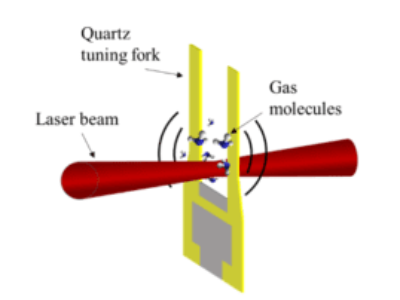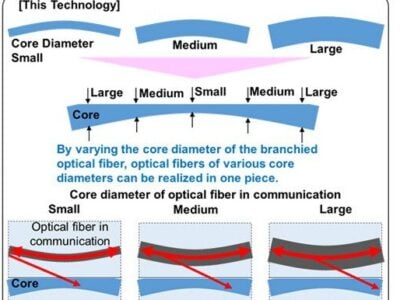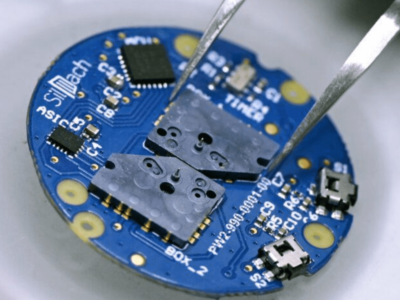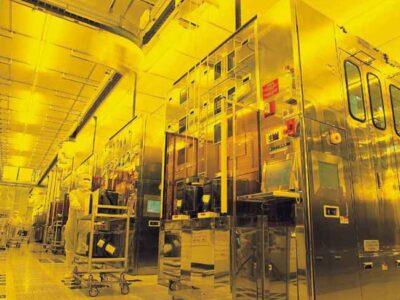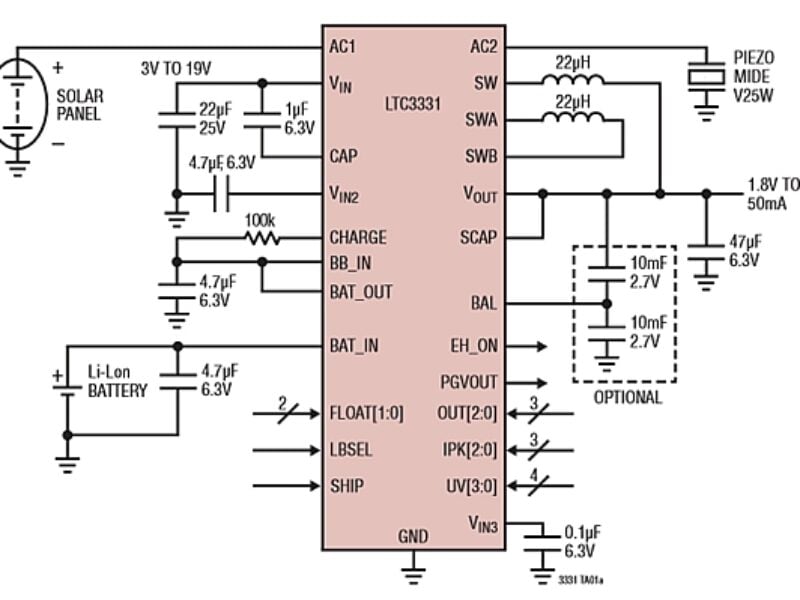
An inflexion point for energy harvesting and the Internet of Things
Background
The portable power application space is both broad and diverse. Products range from wireless sensor nodes (WSNs) that consume average power measured in microwatts to cart-based medical or data acquisition systems with multi-hundred Watt-hour battery packs. However, despite this variety, a few trends have emerged; namely, designers continue to demand more power in their products to support increased functionality and they want to charge the battery from any available power source.
The first trend would imply increasing battery capacities. Unfortunately, users are often impatient and these increased capacities must be charged in a reasonable amount of time, which leads to increased charge currents. The second trend requires tremendous flexibility from the battery charging solution since they need to handle a broad range of input sources and power. Furthermore, the proliferation of wireless sensors supporting the “Internet of Things” (IoT) has increased the demand for small, compact and efficient power converters tailored to untethered lower power devices.
One of the more recent emerging market segments covered under the IoT which is particularly interesting from an energy harvesting perspective is the wearable electronics category. Although still in its infancy, this segment includes such products as Samsung Galaxy Gear and Google Glass. Nevertheless, one specific form factor that has garnered high expectations is that of the wrist watch. I am not talking about the Dick Tracy 1940s 2-way wrist radio in a wrist watch form factor from the classic American comic.
I am referring to today’s versions which have voice and data communication, internet browsing and streaming video capabilities afforded via a Smart phone. There are many examples on the market already, a quick search on Amazon will show over a half-a-dozen such offerings, a prominent example being Qualcomm’s Toq. Nevertheless, it, and many others, look as if they are being overshadowed by the much anticipated and much rumored iWatch from Apple.
Of course, wearable technology is not just for humans, there are many applications for animals too. Recent examples include ultrasound-delivering treatment patches and electronic saddle optimization for horses to collars on other animals that variously track, identify, diagnose and so on. Regardless of the application, most of these devices require a battery as the main power source. However, for human-based applications, it looks like there will soon be wearable fabrics that can generate electricity from the sun.
You can think of them as “Power” suits! One company at the forefront of such research is the European Union funded project Dephotex, which has developed methods to make photovoltaic material light and flexible enough to be worn. Naturally, the material will convert photons into electrical energy, which can then be used to power various electronic devices worn by the user, or to charge their primary batteries, or even a combination of both of these.
Power Conversion Challenges
At the low end of the power spectrum are the nanopower conversion requirements of energy harvesting systems such as those commonly found in WSNs that necessitate the use of power conversion ICs, which deal in very low levels of power and current. These can be 10s of microwatts and nanoamps of current, respectively.
State-of-the-art and off-the-shelf Energy Harvesting (EH) technologies, for example in vibration energy harvesting and indoor or wearable photovoltaic cells, yield power levels in the order of milliwatts under typical operating conditions. While such power levels may appear restrictive, the operation of harvesting elements over a number of years can mean that the technologies are broadly comparable to long-life primary batteries, both in terms of energy provision and the cost per energy unit provided. Moreover, systems incorporating EH will typically be capable of recharging after depletion, something that systems powered by primary batteries cannot do. Nevertheless, most implementations will use an ambient energy source as the primary power source, but will supplement it with a primary battery that can be switched in if the ambient energy source goes away or is disrupted.
Of course, the energy provided by the energy harvesting source depends on how long the source is in operation. Therefore, the primary metric for comparison of scavenged sources is power density, not energy density. EH is generally subject to low, variable and unpredictable levels of available power so a hybrid structure that interfaces to the harvester and a secondary power source is often used. The secondary source could be a re-chargeable battery or a storage capacitor (maybe even supercapacitors). The harvester, because of its unlimited energy supply and deficiency in power, is the energy source of the system.
The secondary power reservoir, either a battery or a capacitor, yields higher output power but stores less energy, supplying power when required but otherwise regularly receiving charge from the harvester. Thus, in situations when there is no ambient energy from which to harvest power, the secondary power reservoir must be used to power the down-stream electronic systems or WSN. Of course, from a system designer’s perspective, this adds a further degree of complexity since they must now take into consideration how much energy must be stored in the secondary reservoir to compensate for the lack of an ambient energy source.
Energy Harvesting Solutions
Fortunately for the designer of such systems, there exist a number of power conversion ICs which have the necessary features and performance characteristics to enable such low levels of harvested power to be used in wearable technology applications. Linear Technology recently introduced its LTC3331 to specifically address this requirement, as illustrated in Figure 1.

Figure 1. LTC3331 Energy Harvester & Battery Life Extender
The LTC3331 is a complete regulating EH solution that delivers up to 50mA of continuous output current to extend battery life when harvestable energy is available. It requires no supply current from the battery when providing regulated power to the load from harvested energy and only 950nA operating when powered from the battery under no-load conditions. The LTC3331 integrates a high voltage EH power supply, plus a synchronous buck-boost DC/DC converter powered from a rechargeable primary cell battery to create a single non-interruptible output for energy harvesting applications such as those in WSNs.
The LTC3331’s EH power supply, consisting of a full-wave bridge rectifier accommodating AC or DC inputs and a high efficiency synchronous buck converter, harvests energy from piezoelectric (AC), solar (DC) or magnetic (AC) sources. A 10mA shunt allows simple charging of the battery with harvested energy while a low battery disconnect function protects the battery from deep discharge.
The rechargeable battery powers a synchronous buck-boost converter that operates from 1.8V to 5.5V at its input and is used when harvested energy is not available to regulate the output whether the input is above, below or equal to the output. The LTC3331 battery charger has a very important power management feature that cannot be overlooked when dealing with micro-power sources.
The LTC3331 incorporates logical control of the battery charger such that it will only charge the battery when the energy harvested supply has excess energy. Without this logical function the energy harvested source would get stuck at startup at some non-optimal operating point and not be able to power the intended application through its startup. The LTC3331 automatically transitions to the battery when the harvesting source is no longer available. This has the added benefit of allowing the battery operated WSN to extend its operating life from 10 years to over 20 years if a suitable EH power source is available at least half of the time, and even longer if the EH source is more prevalent. A supercapacitor balancer is also integrated allowing for increased output storage.
The LTC3129 is a synchronous buck-boost converter that delivers up to 200mA of continuous output current from a wide variety inputs sources. These include single or multiple cell batteries as well as solar panel and supercapacitor inputs. Its 2.42V to 15V input range and 1.4V to 15.75V output range provides a regulated output with inputs above, below or equal to the output. The low noise buck-boost topology incorporated in the LTC3129 provides a continuous transition through all of the operating modes, making it ideal for EH applications that must maintain a constant output voltage even as the input source voltage declines below the output – see Figure 2.

Figure 2. LTC3129 15V/200mA Buck-Boost Converter
The LTC3129 includes programmable maximum power point control (MPPC) capability which ensures maximum power extraction from non-ideal power sources such as photovoltaic cells. Quiescent current of only 1.3µA makes it ideal for always-on and energy harvesting applications in which extended battery run-time is of primary importance. The LTC3129’s constant 1.2MHz switching frequency ensures low noise and high efficiency while minimizing the size of the external components.
Conclusion
Even though wearable applications with energy harvesting systems will have a broad range of power levels for their correct operation, from microwatts to great than 1W, there are many power conversion ICs available for selection by the system designer. However, it is at the lower end of the power range, where nanoamps of currents need to be converted. That’s where the choice becomes limited.
Fortunately, the LTC3331 energy harvester and battery life extender, along with the LTC3129 low power synchronous buck-boost converter provide extremely low quiescent currents, making them ideal for a broad range of low power applications. Quiescent currents of less than 1.3µA prolong battery life for keep-alive circuits in portable and wearable electronics, while allowing a new generation of EH applications. This is good news indeed since we are moving toward the inflexion point for energy harvesting and the internet of things.
 If you enjoyed this article, you will like the following ones: don't miss them by subscribing to :
eeNews on Google News
If you enjoyed this article, you will like the following ones: don't miss them by subscribing to :
eeNews on Google News

